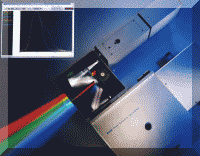|
Instrument Database:
Photon Technology International Inc - TimeMaster
| |
|

|
| |
|
| |
|
| Year of introduction |
|
| Status |
available |
| Company |
Photon Technology International Inc
|
| Categories |
Spectrometer ( Molec. ): Fluorescence
|
Fast - Easy-to-Use - Sensitive - Versatile
Interest in the determination and monitoring of fluorescence and phosphorescence lifetimes has grown dramatically in the past few years. The three most common techniques for measuring fluorescence lifetime are time correlated single photon counting (TCSPC), phase modulation and the stroboscopic (Strobe) technique. Having been a manufacturer of instruments using the TCSPC technique for many years, PTI recognized the clear advantages offered by the computer-controlled strobe technique and launched an R&D program to develop the Timemaster™ series. The result is that PTI offers a complete range of lifetime systems covering all possible applications.
An outline of the advantages of TimeMaster™ instruments
- Fast acquisition times, with directly recorded time resolved emission spectra and fluorescence decays, not limited by the inefficiency of photon counting statistics.
- Fluorescence lifetimes down to 100 pico-seconds, and time increments as short as 5 pico-seconds per point, giving accuracies that are more than comparable with the other techniques.
- Non-linear timescales can be used. Logarithmic Timescale Data Acquisition (LTDA) allows the accurate measurement of several decay values in a multi-exponential decay, even though there may be differences of many orders of magnitude between them. Extracting decay times that are so widely separated by running one single experiment is impossible to do with frequency domain, and other time domain detection systems limited to linear timescales. In fact, separate experiments would normally be required.
- The very high sensitivity of the PTI LaserstrobeTM System can be demonstrated by generating the fluorescence decay curve for 7 picomolar fluorescein with excitation at ~480nm in approximately 5 minutes....
The TimeMaster™ Model C-700F
This entry-level system is an L-format cuvette-based fluorescence lifetime spectrometer where excitation and emission wavelengths are selected by preset bandpass filters. It is capable of measuring fluorescence lifetimes down to 100 picoseconds. A nanosecond flash lamp provides high-intensity illumination and is directly coupled to the sample compartment, which contains a standard 10 x 10 mm thermostatable cuvette holder with microstirrer.
The TimeMaster™ Model C-720
Adding a nitrogen dye laser provides high-intensity illumination that is fibre-optically coupled to the sample compartment. Any excitation wavelength between 360 - 990 nm is now selectable. Furthermore, the addition of a 1/4 metre Czerny-Turner emission monochromator provides emission scanning capabilities.
This lifetime spectrometer is capable of measuring fluorescence lifetimes down to 100 picoseconds as well as performing time-resolved emission spectroscopy. The sample compartment will accept optional polarizers and other accessories. Emitted light is collected by quartz optics and passed through the monochromator to a stroboscopic detector. All system functions are under computer control. Data is collected and analyzed by proprietary Windows 98-based advanced fluorescence software with exclusive NTDA (non-linear timescale data acquisition) capability. This is the most widely used system supplied by PTI.
The above examples represent just two of the numerous configurations available. As the specific instrumentation for a particular application varies enormously, PTI can tailor each TimeMaster system to an individual user\'s need. Please contact your sales representative for custom requirements.
TimeMaster systems are used in a variety of applications:
- Protein structure/function studies
- Structure and dynamics of biological membranes
- Drug Interaction with proteins
- Photosynthesis research
- Time-Resolved fluoro-immunoassays
- Structure and dynamics of nucleic acids
- Lifetime-based oxygen sensing
- Fluorescence lifetime microscopy in cells
- Reaction kinetics in micellar structures
- Electron and proton transfer
- Polymer structure and dynamics
- Polarization/Anisotropy studies
|
| Specifications |
|
|
|